- Home
- Winston Groom
Shiloh 1862 Page 3
Shiloh 1862 Read online
Page 3
Thus the South viewed it with alarm when, in the 1820s, Northern abolition parties first made themselves known. Initially the abolitionists had declared slavery to be a social evil and lobbied to ship freed slaves back to Liberia, on the west coast of Africa. They would later change this tactic, but first, in 1828, during the presidency of John Quincy Adams—and against the strenuous objections of its Southern members—Congress passed a revenue tariff that caused the prices of goods that southerners typically purchased to soar by 50 percent.
It was quickly dubbed the “tariff of abominations” by enraged southerners, and in South Carolina the notion of secession first reared its head when the legislature passed a law asserting that no state was bound to enforce a federal law that it found obnoxious. This produced the so-called Nullification Crisis, which pitted the power of an individual state against the power of the federal government, and Marbury v. Madison be damned.1
Outright rebellion was diffused after President Andrew Jackson inherited the controversy and threatened to enforce the law, with military action if necessary, but it left a bitter taste in the minds of most southerners, who saw the legislation as a slap in the face against the South.2 At times, Southern historians have tried to argue that the tariff was the root cause of the Civil War, but that is untrue. It is fair to say, however, that it was a critical ingredient in the onset of Southern mistrust of the North and also seemed to have created a mazy kind of dividing line in which the South began to think of itself as a separate entity with the right to withdraw, or secede, from the Union if given just cause.
The tariff, which had become abominable for everybody, thus set the stage for the states’ rights dispute, which pitted states’ laws against the notion of federal sovereignty, an argument that continued into the next century, and the next. States’ rights political parties sprang up across the South during the 1830s. A noteworthy example of just how crucial the issue had become was embodied in the decision in 1831 by Mr. and Mrs. Nathaniel Gist (ironically from Union, South Carolina) to name their firstborn son States Rights Gist, which he bore proudly until November 30, 1864, when, as a Confederate brigadier general, he was shot dead leading his men at the Battle of Franklin, Tennessee.
The squabble naturally spilled over into politics. The North, with its millions of immigrants pouring in, hopelessly outnumbered the South in population and thus controlled the House of Representatives. But by a sort of gentlemen’s agreement the Senate had effectively remained fifty-fifty, because whenever a territory was admitted to the Union as a free state the South was “allowed” to add a corresponding slave state—and vice versa.3
But in 1820, when Missouri applied for statehood and antislavery forces insisted it must be free, there were no other slaveholding territories to offset the addition. Ultimately, this resulted in the Missouri Compromise (brokered by Senator Henry Clay of Kentucky), which decreed that Missouri could come in as a slave state but that any other state created north of Missouri’s southern border would have to be free. That held the thing together for 30 years—longer than it deserved.
By the 1840s abolitionism had become a full-fledged movement, with preaching from pulpits, stumps, and lecture halls across the North; the abetting of runaway slaves via the Underground Railway; and the distribution of pamphlets and other antislavery literature in the Southern mails. Not only that, the abolitionists had modified their position that slavery was merely a “social evil,” condemning it now as a “moral wrong,” and began to agitate on that basis.
This shocked and angered many churchgoing southerners, who were distressed at being called scandalous names by northerners they did not even know. In turn, that inspired religious schisms that caused the Baptist and Methodist churches to split into Northern and Southern denominations. The Presbyterians hung together, but it was a strain, while the Episcopal Church remained a Southern stronghold and firebrand bastion among the wealthy and planter classes. Catholics also maintained their unity, prompting cynics to suggest it was only because they owed their allegiance to the pope of Rome rather than to any state, country, or ideal.
Meantime, the cotton revolution had caused the southerners to evolve their notion of slavery as well, from a “necessary evil,” which is how Thomas Jefferson once characterized it, to a “positive good,” according to John C. Calhoun, South Carolina’s prominent U.S. senator, a generation later. This naturally infuriated the abolitionists, who redoubled their efforts, prompting southerners to assert that the North was agitating for a murderous slave rebellion. Slave revolt was a horror that remained high on most southerners’ anxiety list. Bloody slave uprisings had occurred in Haiti, Jamaica, and Louisiana, and more recently resulted in the killing of 60 whites during the Nat Turner revolt in Virginia in 1831.
During the Mexican War of 1846–48 the United States acquired vast territories in the West, which southerners sought to colonize as slave states. It was not so much that they believed slavery would be successful in the West—because of the climate and terrain most people in fact did not think so—but rather for purely political reasons having to do with control of the Senate.
Early in that conflict, a near crisis arose when an obscure congressman from Pennsylvania placed an amendment onto the war funding bill of 1846 that would have banned slavery in any territory the United States acquired from Mexico, which became known, after its author, as the Wilmot Proviso. It did not pass into law, but the mere act became a cause célèbre for southerners, who offered it as further evidence that the North was out to destroy not only slavery but the South’s political power as well.
The 1850s brought new levels of anger fueled by “fire-eaters” in the South and “black radicals” in the North, backed by their newspapers and journals. By then the arguments of national politics had become almost completely sectional and adversarial. In 1850, when California sought to join the Union, it was admitted as a free state, prompting South Carolina’s Calhoun, then nearly on his deathbed, to declare that the move had “upset the equilibrium of the nation and [would] lead to Civil War.”
To assuage the furious South, Congress passed the Fugitive Slave Act, a law that made northerners personally responsible for the return of runaway slaves. Where before many in the North had little or no opinions or feelings on slavery, this law seemed to demand their direct assent to the practice of human bondage, and it galvanized Northern sentiments against slavery.
Another polarizing incident between the two sections occurred upon the 1852 publication of Harriet Beecher Stowe’s best-selling novel Uncle Tom’s Cabin, which depicted the slave’s life as a relentless nightmare of sorrow and cruelty. Northern passions were incensed and inflamed, while southerners dismissed the tale as outrageously skewed, overdramatized, and unfair.4
In 1854 agitation by both sides over the future of the Kansas Territory resulted in the Kansas-Nebraska Act, sponsored by future presidential candidate and Lincoln debater Stephen A. Douglas. This new law overturned the Missouri Compromise and authorized settlers in the Kansas Territory to decide for themselves whether they wanted their state to be slave or free. This was known as “popular sovereignty.”
Outraged abolitionists began raising funds to send antislavery settlers to Kansas, prompting equally outraged southerners to fund their own settlers, and a brutish group from slaveholding Missouri known as Border Ruffians went into Kansas to make trouble for the abolitionists. Into this ill-fated mix rode an abolitionist fanatic named John Brown with his three sons, and as the murders and massacres began to pile up, newspapers throughout the land began to carry headlines of “Bleeding Kansas.”
Other changes were in store for the political class, especially in the Senate, where southerners had dominated, if not always in numbers, at least in oratory style. For every Yankee Daniel Webster, it seemed, there was a Henry Clay, or a Calhoun, or a Thomas Hart Benton to speak the part of the South. But in 1851 two new Northern senators—then Democrats but soon to be Radical Republicans—entered the chamber. Together, they broug
ht great political weight and bearing to what was otherwise a notoriously staid and compromising body politic.
Judge Ben Wade of Ohio was one of them and 40-year-old Charles Sumner of Massachusetts was the other. Sumner was tall, statesmanlike, and had the looks of “an Apollo,” a sharply honed, speechified Boston lawyer who was vehemently opposed to slavery. Wade, on the other hand—and this according to an admirer—was a “self-made, untutored yokel, heavy, old, glum and square,” who not only opposed slavery but had the brass to silence those who weren’t. Once seated in the formally genteel Senate chambers Wade was just uncouth enough to shout “You’re a liar” at gentlemen from the Cotton Kingdom who were trying to defend their “peculiar institution,” as slavery had come to be known. And when the Southern gentlemen objected to his behavior, Wade was just bold enough to retort “Well, what are you going to do about it?”
Those words were far more weighty than they are now, for while the practice of dueling over insulted honor was banned in many states and the District of Columbia, it was still very much alive as means of settling personal disputes, including those in Congress. In Ben Wade’s case, his reputation had preceded him. He was vouched to be an expert shot with a squirrel rifle from his days as a backwoodsman, and the advantage Wade had—and he knew it—was that, if challenged, the choice of weapons would be his. And Southern gentlemen, while they may have been many things, were rarely accomplished squirrel hunters.
Wade’s tactics soon cast a pall over the Southern senators, who at least had better judgment than to face Wade’s squirrel rifle on the field of honor, even as they seethed furiously at the embarrassment of their situation. For its part, the Southern press held up Wade as an indelible symbol of that bullying kind of Yankee, the abolitionist tyrant.
Senator Sumner, on the other hand, owned no squirrel rifle, or weapon of any kind, so far as it was known, but relied on logic, a higher sense of morality, and advanced oratory skills to overwhelm opponents in the slavery debates. Southerners, already careful, lest they provoke Ben Wade, generally chose their words cautiously, but nevertheless managed to drive home the point that so far as old Dixie was concerned slavery wasn’t going away and in fact was destined to spread to the far-flung outlands of the nation.
One day in 1856 Senator Sumner startled even his fellow radicals during a lofty, three-hour disquisition against slavery by singling out his colleague Andrew Butler for a severe personal ridicule. Among other things, Sumner declared that Senator Butler kept “a mistress who, though ugly to others, is lovely to him … I mean the harlot, slavery”; moreover, he further proceeded to mock the 59-year-old South Carolinian, who had suffered a stroke, for his posture and manner of speech.
This so infuriated Butler’s nephew, a congressman named Preston Brooks, that two days later he accosted Sumner at his desk in the Senate chamber and caned him nearly to death with a gold-headed gutta-percha walking stick.
The incident triggered profound indignation throughout the North and helped give rise to the formation of the Republican Party, which had a firm antislavery platform.5 Later that year the Republicans’ candidate for President was the western explorer John C. Frémont, the famed “pathfinder” of the 1840s, and even though Frémont was defeated his candidacy established the Republicans as a force to be reckoned with.
By this time the country had been lurching from political crisis to crisis for more than a decade, and secession talk increasingly inflamed the South and was seriously taken. In 1857 the Supreme Court delivered its infamous Dred Scott decision, which elated southerners and enraged northerners. It was the opinion of the court that a slave was neither a “citizen” nor, for that matter, even a “person,” and “so far inferior that [slaves] have no rights which the white man [is] bound to respect.” The immediate effect of the ruling was that southerners could now move their slaves into and out of free states and territories without losing them; for northerners the decision drove more people into the antislavery camp.
In 1859 John Brown, of “Bleeding Kansas” notoriety, staged a murderous raid on the U.S. arsenal at Harpers Ferry, Virginia, in hopes of inspiring a general slave uprising. The raid was thwarted by U.S. troops, and Brown was tried for treason and hanged, but when it came out that he was being financed by wealthy Northern abolitionists, Southern anger was profuse—especially after the Northern press elevated Brown to the status of hero and martyr.
As the election year of 1860 approached it seemed the nation was consumed in a furor as political parties dissolved or split into factions. Influential Southern fire-eaters insisted that Northern “fanatics” intended to free the slaves “by law if possible, by force as necessary,” and hectoring Northern newspapers and orators (known as “black” or Radical Republicans) provided ample fodder for that conclusion.
When the Republicans nominated Abraham Lincoln as their candidate, the Southern press whipped up its populace to such a pitch of fury it seemed as if John Brown himself had been put on the ticket. Lincoln was lampooned in words and cartoons as an archetypal abolitionist—a kind of Antichrist who would turn loose the slaves to rape, murder, and pillage. This goes a long way in explaining why fewer than one in three Confederate soldiers came from slaveholding families. To them, it wasn’t to keep slaves that they joined the army, it was rather to save their homes and families against the notion of slaves gone wild.6
Meantime, the Northern press was pouring fuel on the fire by damning southerners as brutal lash-wielding torturers and heartless family separators. By the time hostilities broke out, neither side had much use for the other. One elderly Tennessean later penned this sentiment: “I wish there was a river of fire a mile wide between the North and South, that would burn with unquenchable fury forevermore, and that it could never be passable to the endless ages of eternity by any living creature.” With talk like that it’s a wonder the war didn’t start earlier.
The new alignment of political parties ultimately ensured a 40 percent plurality victory for Lincoln.7 With the inclusion of Minnesota (1858) and Oregon (1859) as free states, the southerners’ worst fears were about to be realized—complete control of both Houses of Congress and the White House by free-state, antislavery politicians.
Much of the Southern apprehension that Lincoln would free the slaves was misplaced. No matter how distasteful he found the practice, the overarching philosophy that drove Lincoln was a hard pragmatism that did not include forcible abolition by the federal government, probably for the simple reason that he could not envision any political way of accomplishing it at the time. By then, though, southerners’ mistrust had degenerated into such a caustic fog of hatred, recrimination, and outrageous statements that most in the South simply did not believe Lincoln when he promised he had no interest in abolishing slavery where it already existed.
However, like a considerable number of Northern people, Lincoln was decidedly against allowing slavery to spread into new states and territories. By denying slaveholders the right to extend their boundaries he not only would have weakened the slave power in Washington, but over time it would have almost inevitably resulted in the voluntary abolition of slavery, since sooner or later the Southern land would have worn out from overfarming with cotton.
The southerners weren’t sticking around to find out. In short order, pugnacious South Carolina voted to secede from the Union, followed by eight other Deep South states that were heavily invested in cotton. After South Carolina drove Federal forces from Fort Sumter in the Charleston harbor, Lincoln called for the other states to produce 75,000 volunteers to put down the rebellion, which resulted in further secession. Virginia, North Carolina, Tennessee, and Arkansas joined the Confederacy rather than fight against their fellow southerners.
A Southern woman was heard to lament at the time that “Because of incompatibility of temper … we have hated each other so. If we could only separate, a ‘separation a l’agreable,’ as the French say it, and not have a horrid fight for divorce.”
That was not to be. Duri
ng the early months of 1861 Lincoln was able to quell secession in several of the so-called border states—including Missouri, Kentucky, and Maryland—by a combination of politics and force, including suspension of the Bill of Rights. But by the spring of 1862 it was painfully apparent that the “horrid fight for divorce” could not be avoided. To be sure, there had been fighting and killing in 1861, but with the exception of Bull Run and a few others most of those actions were in the nature of skirmishes that did not rise to the dignity of a “battle.”
That was the reason why on Sunday morning, April 6, 1862, tens of thousands of boys in blue were encamped at Pittsburg Landing, and tens of thousands more dressed in gray or butternut were stealthily marching toward them through the deep Tennessee woods. Everyone knew that a big battle had to be fought; battles were what settled things. The armies had gathered; the line had been drawn. It is impossible to guess how much of the foregoing history these soldiers apprehended, but most of them by then understood they were destined to be part of something very great, and very awful, and that sooner rather than later they were going to see that elephant.
1 This was the 1803 case in which the U.S. Supreme Court established the precedence of federal law over state law.
2 The historian Robert Remini, biographer of Adams and Jackson, described the tariff as both “ghastly” and “lopsided.”
3 For instance, when Texas was admitted to the Union in 1845 as a slave state, so also was Iowa, which came in as a free state in the following year.
4 After the conflict began it was said that Abraham Lincoln, upon meeting Mrs. Stowe, remarked, “So you are the little lady who started this great war.”

 El Paso
El Paso Better Times Than These
Better Times Than These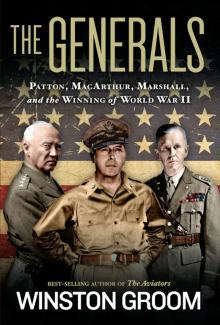 The Generals
The Generals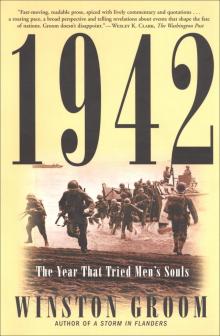 1942: The Year That Tried Men's Souls
1942: The Year That Tried Men's Souls Forrest Gump
Forrest Gump Gump and Co.
Gump and Co. The Aviators
The Aviators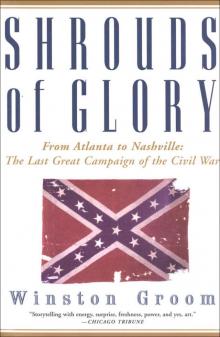 Shrouds of Glory
Shrouds of Glory Patriotic Fire
Patriotic Fire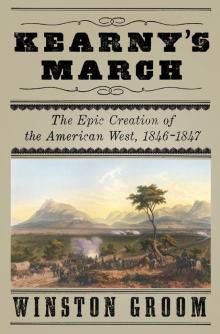 Kearny's March
Kearny's March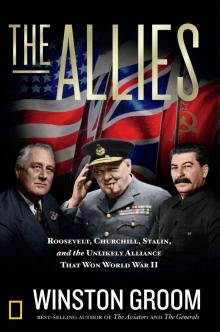 The Allies
The Allies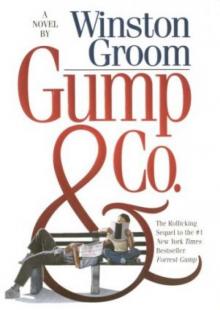 Gump & Company fg-2
Gump & Company fg-2 Forrest Gump fg-1
Forrest Gump fg-1 The Aviators: Eddie Rickenbacker, Jimmy Doolittle, Charles Lindbergh, and the Epic Age of Flight
The Aviators: Eddie Rickenbacker, Jimmy Doolittle, Charles Lindbergh, and the Epic Age of Flight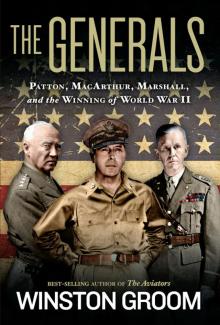 The Generals: Patton, MacArthur, Marshall, and the Winning of World War II
The Generals: Patton, MacArthur, Marshall, and the Winning of World War II